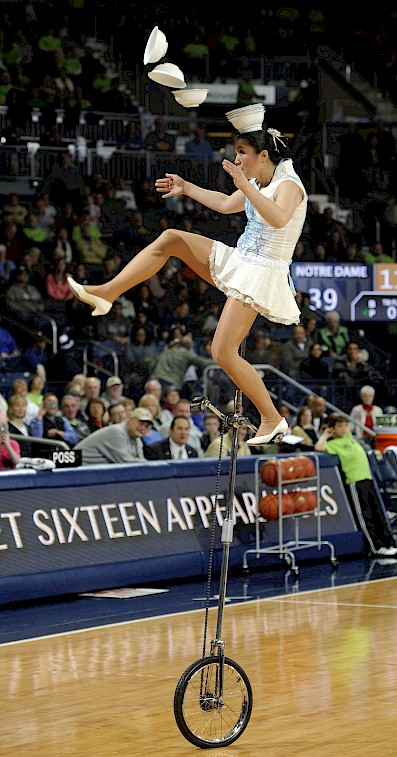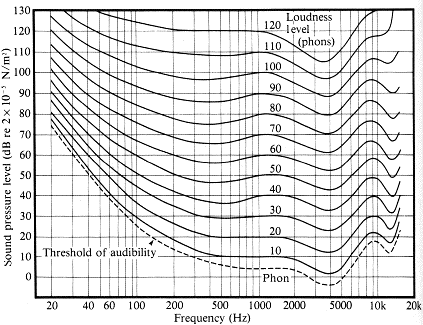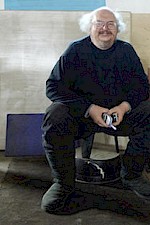The High Wire Act of the Speaker Designer – Keeping Sound in Balance
Designing speakers is a balancing act akin to walking a high wire high above an arena floor. Lean too much one way and you fall. Lean too much the other and it’s all over. Make a mistake and it can kill you. Proceed with too much caution and not enough flair and you’re perceived as too timid.

Nature’s Variety
All natural sounds are extremely varied in their mixture of frequencies and the loudness of these frequencies. If you compare two instruments (playing the same note at the same loudness), the actual mix of frequencies and loudness produced by one will be quite different from the other. It is this difference in balance of mixed frequencies (and the balance of loudness levels at each frequency) that we use to perceive which instrument is playing. Our ear/brain audio analyzer is quite good and can usually make these distinctions over a very wide range of absolute sound levels. Absolute sound levels give you extra information like how close you are to the source. This is partially because equal Sound Pressure Levels (SPL) over human hearing range are very different from perceived equal loudness levels.
Unequal Hearing of Loudness – Fletcher/Munson
In the 1930’s, Bell Telephone was researching the most effective way to send voices over wires. Two researchers, Harvey Fletcher and Wilden A. Munson presented a paper in the Journal of the Acoustic Society of America entitled “Loudness, its Definition, Measurement and Calculation.” In the paper they published a set of curves showing how loudly (in SPL) you needed to play different frequencies in order to be perceived at the same loudness. 1000 Hz was the reference frequency. A curve determined at 10 dB steps the loudness of a mosquito at 10 dB to over 120 dB near the threshold of pain. What they found was that humans are most sensitive to sound at about 3000- 3500 Hz (the typical resonance of your ear canal). Hearing became dramatically less sensitive an octave higher and substantially less sensitive two or three octaves lower. And equally important, at the higher overall levels, the boost (in SPL) needed to perceive the same sound level is much less. This is to say, human hearing response is much flatter at high sound levels. I view these curves as the inverse of hearing sensitivity: highest in the mid-range a falling off in the bass and treble – and the balance varying with level.

How much does this affect your experience?
How much does this affect music and listening to recorded music? Tremendously! If you listen to a rock song produced to sound best at 100 dB (concert level) played back at 70 dB (typical vacuum cleaner level) you will hear the vocals and lead guitar OK, but miss the foundation provided by the bass guitar and toms, as well as the metallic sizzle of the cymbals. At this low listening level, the judicious use of tone controls (if you have them) can recover much of the lost foundation and detail without a big increase in overall SPL. In fact, you can decrease the volume knob setting, while increasing the bass and treble to get much more lifelike reproduction than all flat at 70 dB.
In the Golden Age of Audio, there was a Loudness Control to change the balance with the setting of the Volume Control. The better Loudness Controls decreased the effect as the volume control was turned up and the response became flat for much of the higher levels. The best loudness controls also allowed the user to adjust the level where this compensation began to take place. This allowed the loudness control to work in different size rooms and with speakers with different sensitivity. They were very useful when listening at lower levels.
How Much Does This Affect Speaker Design?
Again, tremendously! At the very beginning, when a speaker designer starts thinking about a new design, the expected use of the new product dominates the design considerations. Where will it be used? How close will it be to the listener? How loudly will it be played? All of these affect the design considerations. How big it can/must be? How sensitive it can/must be? What frequency balance is needed? Each choice constrains the design. When the target is to reproduce a musical performance (at least at least as it is experienced by the audio engineers) and not just to meet some measured specifications, it all becomes a mashup of trade-offs. The final result and test is yourexperience.
The “Right” Speaker of the House
How much should this affect your choice in speakers? And, again tremendously! You must audition prospective speakers in a room near your size and at listening levels that you will use for critical listening. This usually means in your home, with your equipment with your sources. Room placement has a big effect on the perceived balance of your system and you can use this to your advantage to get the best sound possible.
When we established our sales model, we felt strongly enough about home auditions to build them in. Ohm provides a 120-day home trial for our speakers. If, after 60 days, you are unhappy with the sound, you can let us know and we will address the problem, We understand that each room is unique as is the particular hearing acuity, taste in music, SPL comfort level, etc. of the listener. At Ohm, we feel it is our job to provide our customers with the finest music reproduction experience we can. If that means exchanging drivers, entire speakers or other modifications, we will make the accommodations.
We can do that because we were set up to do business that way. Not many – if any – other companies are. So, the next best option is finding a dealer who is willing – and eager – to give you a home trial of the speaker of your choice. Make sure that the dealer is willing to take the speakers back if you’re not fully pleased. Then, live with the speakers. Try a broad spectrum of the music you love on them. Share your feelings with the dealer. And change them out if necessary.
I have found over the years that while getting the right balance in my speaker design is one of the harder parts of the job, once I have succeeded – somehow the rest of my life feels better balanced, too.
See you in two weeks,
Until then Enjoy & Good Listening!
John
Subscribe to Ohm News & Views to get the latest posts in your inbox
John Strohbeen Author
John Strohbeen was the founder and president of Ohm Speaker.


